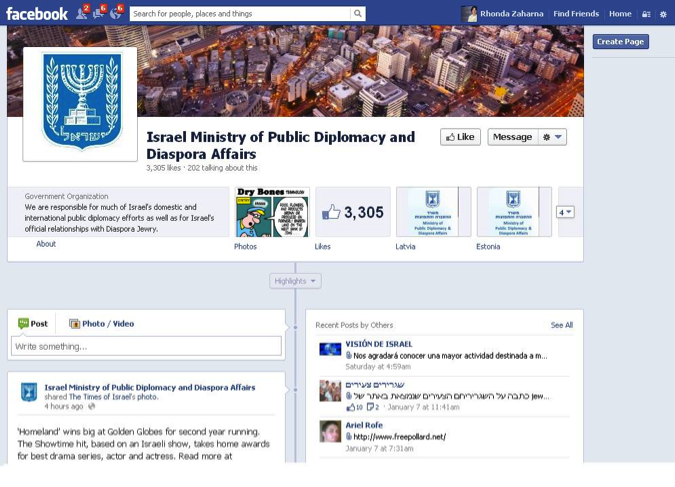A recent book from Martha Bayles, a lecturer in humanities at Boston College, tackles the question of how American entertainment industry products confound official U.S. government efforts to represent the nation to...
KEEP READINGThe CPD Blog is intended to stimulate dialog among scholars and practitioners from around the world in the public diplomacy sphere. The opinions represented here are the authors' own and do not necessarily reflect CPD's views. For blogger guidelines, click here.
Culture Posts: Relationalism – Implications for Public Diplomacy
To celebrate the New Year, Culture Posts is focusing on the relatively new concept: relationalism. Public Diplomacy viewed through the lens of relationalism has several implications. Most immediately, discussions about relations and relationship-building – the hallmark of the “new public diplomacy” – can move to a more sophisticated and nuanced level.
Developing a Relational Eye
Relationalism is a 3rd dimension that falls in between individualism and collectivism. What is most significant about relationalism is that it assumes that everything is connected. This is a radical shift in perspective.
Both individualism and collectivism assume that individuals or groups are separate or dis-connected. Attention focuses on how to create relationships. In public diplomacy, that assumption has spawned a corresponding assumption on the need for “engagement” and “relationship building.”
Relationalism, by assuming connections rather than trying to create them, advances public diplomacy to another whole realm. Relationalism can help practitioners and scholars develop a “relational eye” for seeing underlying features, nuances and patterns of connections that already exist. Several aspects are readily apparent.
1- Public Diplomacy as Navigating Networks
Carol Gilligan, mentioned in the previous post on the emergence of relationalism, is the same Harvard scholar mentioned by Anne-Marie Slaughter in her oft-cited 2009 Foreign Affairs piece “America’s Edge: Power in the Networked Century.
Slaughter suggested that Gilligan’s depiction of the different views of the world-as-hierarchies and world-as-networks captured the difference between the 20th century and the 21st century.
As we move deeper into the 21st century, those who master network dynamics will have the edge. At present, network-based public diplomacy, indeed much of social network analysis, focuses on individual-level, or ego-centric networks and how individuals agency creates relations and ultimately networks. Whole network analyses, as scholars note, are “rare.”
Relationalism begins with the bird’s eye view of the whole network. Relationalism assumes that the individual is already embedded in a network. Rather than create relations, the challenge is to skillfully navigate networks. Relationalism gives added insight into what Slaughter suggested by moving to the center of a network.
* Bundled, Mass audience →Networked audience
Not only are public diplomacy actors connected, so too are intended publics. At present, the prevailing view of audiences is similar to what the famed Chinese scholar Fei Xiaotong described as the individual rice stalks gathered into bundled categories. Publics and audiences are viewed primarily in terms of regions, demographics, interests, or even religion.
Public diplomacy tends to place audience in categories rather than networks of relations.
Yet, the idea of a “mass audience,” as I wrote about in Battles to Bridges, can be especially deceiving for mass media initiatives. The media may be mass, but the audience is not one undifferentiated “mass,” but rather a web of viewers who discuss and now share what they see with others.

Relationalism highlights the interconnectivity and interactivity of the audience. How audience members perceive mass-mediated messages can become amplified – both positively and negatively – within highly networked audiences.
Audience Attributes → Sponsor Relations
Traditionally, public diplomacy, like much of communication proceeds from two critical questions: “Who is our audience?” and “What is our message?” Communicators carefully research the attributes of the audience so they can create messages that positively resonate with the audience.
However, the very idea of sending messages hinges on the assumption that the parties are separate.
Relationalism stimulates public diplomacy planners to shift attention away from static attributes of the audience to the audience’s relations with the sponsor. Policy may be a critical aspect of audience-sponsor relations. The critical question is: “What are our relational dynamics with the public?” Messages sent out without regard to the underlying relations may produce unintended consequences. Also, under the logic of relationalism, perceived affinity may carry equal if not more weight than credibility.

On the surface, China’s move into Africa may appear to be an assertive “Charm Offensive.” However, under the lens of relationalism, the Sino-African relational dynamics are quite substantial and not a new phenomenon. The voyages of Chinese Admiral Zheng He (1371–1433) included detailed study of local culture, and reciprocal exchanges of gifts and visits. Like her African brothers, China later shared the historical experience of exploitation and humiliation of foreign colonial intervention. China’s medical and disaster relief dates back to the 1960s. Although there are not many Confucius Institutes in Africa, these cultural institutes are built on a relational network model.
Domestic & Diaspora Publics
Public diplomacy often assumes that the target audience is foreign publics. Relationalism assumes that a nation’s audiences radiate outward, similar to Fei’s concentric circles. The most immediate audience is the domestic public, followed by the diaspora, then close regional or affinity publics, and then geographical or ideological distant publics to ultimately the generic global public.
The importance of domestic and diaspora public can be seen in a relational view of nation branding initiatives. Two strong campaigns, Colombia es Pasión and South Africa’s Alive with Pride were built on a securing domestic buy-in before trying to sell to foreign audiences.
One recent innovative campaign – Brand Haiti – was launched by a group of Haitian diaspora students. They wanted to re-brand their country’s negative image after the 2010 earthquake. In 2012 the students reached out to fellow students to join them for Spring Break in Haiti – serious fun, serious business.

Former Indian ambassador Kishan Rana, who has written about diaspora diplomacy, identified Israel as the clear leader in diaspora diplomacy. One can see prominence of the diaspora even in the name of the agency charged with Israel’s communication: Ministry of Public Diplomacy and Diaspora Affairs. Facebook is just one of many ways the Ministry is using social media tools to cultivate relations with its diaspora.

On the Cutting Edge: Collaborative Public Diplomacy
In his new book on Collaborative Public Diplomacy, Ali Fisher talks about the importance of not having the answers, “No one actor has the answer; it must be generated collaboratively.” Relationalism is based on the implicit understanding that no entity is truly separate, or dis-connected from others even on a global scale. Any effort to assert one answer may have unintended consequences that ultimately reverberate back to the original source. The move from competitive to cooperative to collaborative public diplomacy represent significant shifts in the conception and practice of public diplomacy.
New Perspectives, New Visions of Public Diplomacy
As Bruce Gregory and others have observed, the field of public diplomacy has been dominated by the U.S. experience and practice of public diplomacy. It is most likely that the U.S. model contains features of individualism, particularly the idea of individual agency and assertiveness. With the development of a relational perspective, we are likely to see new models of public diplomacy. Scholars in Asia, and particularly China, have been particularly active. These new models represent new tools for the practice of public diplomacy and new visions to peer into public diplomacy’s horizon.
Envisioning Relationality
Although relationalism may not have found its way into the dictionary, that may change as we move further into the new century. Change may also come when we move, as Yoshitaka Miike suggests, from simply learning about cultures to learning from other cultures.
Today, relationalism provides a lens for appreciating the nuances of the “relational turn” in public diplomacy. One day when relationalism and relationality becomes as common as individuality and individualism, we may look back and wonder how on earth we missed seeing it.
** I wish to thank CPD Masters student Amy Yu for her valuable research assistance with this relationalism series and Nathalie Cazeau for research on Brand Haiti. [AND ALWAYS – Naomi and David!!!]
Visit CPD's Online Library
Explore CPD's vast online database featuring the latest books, articles, speeches and information on international organizations dedicated to public diplomacy.
POPULAR ARTICLES
-
November 3
-
November 5
-
November 13
-
November 25
-
December 17
Join the Conversation
Interested in contributing to the CPD Blog? We welcome your posts. Read our guidelines and find out how you can submit blogs and photo essays >.













